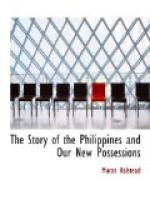There is history, romance and tragedy in the martyrdom of Dr. Rizal, whose execution by shooting on the Luneta two years ago is a notable incident of the cruelties of Spanish rule. This was on account of the scholarship, the influence, the literary accomplishments, and the personal distinction of the man. Dr. Rizal was easily the foremost writer his race and country has produced. He was a poet, novelist, political essayist, and historian, and his execution was for the crime of loving his country, opposing the Spaniards, criticising and lampooning the priests. He is called the Tagalo Martyr, for he was of the tribe of Malay origin, the most numerous and rebellious in the Philippine Islands. His fate was shocking. He was an intelligent, learned man, an enthusiastic patriot, who had been educated in Spain and France. For writing a book against Spanish oppression he was exiled to the Island of Dapitan. There he met a young woman of Irish parentage, with whom he fell in love. They were engaged to be married, when, on some pretext, the Doctor was brought back to Manila, sent to Madrid to be tried, and then sent back to Manila. The unhappy girl to whom he was betrothed tells the rest of the story:
“Everyone knew that Dr. Rizal was innocent. All that could be brought against him was the publication of his book, and the Spanish officials who tried him had never even read it. Nevertheless, he was condemned to death. I then asked permission to be married to him, and they granted my request, thinking to add to the horror of his martyrdom. The marriage was celebrated by a friar the same day on which he was sentenced. I passed the whole night on my knees in prayer before the prison door, which shut my husband from me. When morning dawned, the Doctor came out, surrounded by soldiers, his hands bound behind his back. They took him to the Luneta, the fashionable promenade of the city, where all military executions take place. The lieutenant in command of the firing party asked my husband where he would prefer to be shot. He replied ‘Through the heart.’ ‘Impossible,’ said the lieutenant. ’Such a favor is granted only to men of rank. You will be shot in the back.’ A moment after my husband was dead. The soldiers shouted, ‘Hurrah for Spain,’ and I, ’Hurrah for the Philippines and death to Spain.’ I asked for the body. It was refused me. Then I swore to avenge his death. I secured a revolver and dagger and joined the rebels. They gave me a Mauser rifle, and the Philippines will be free.”
In his poem, filled with his last thoughts—his exalted dreams that had faded, his patriotic sentiments that were bloody dust and ashes, his love for the woman he was allowed to marry a few hours before he was shot, his woeful love for his troop of devoted friends, who would have died for him and with him if the sacrifice then and there had not been hopeless—it will be discovered that he was a true poet, and we give one of his stories that was hostile to the orders of the Church, and a satire on Spanish rule, showing why he was a martyr.




